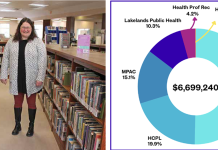County coun. Jennifer Dailloux termed the state of a 10-year housing and homelessness plan a “bone-chilling nightmare” during a special council meeting Oct. 25.
Her comments came after a presentation from City of Kawartha Lakes – human services division employees, Kirstin Maxwell, CEO of Kawartha Lakes Housing, Michelle Corley, manager of human services, and Don Quibell, manager of building and property.
Corley said the current 10-year plan was established in 2020 but most of the work leading up to it occurred in 2019.
It concluded 750 new affordable housing units were needed in the Highlands by 2029. The County determined it needed partners, with the KLH Housing Corporation building 150 new affordable rental units and non-profit partners and private developers each contributing 50, while accessing approximately 500 existing or new market rent units to make them affordable through rent subsidies.
Slide after slide showed the challenges. For example, there are now 2,383 households waiting for community housing in the region, a more than 300 per cent jump over a 10-year timeframe. People are waiting 10-plus years.
Between 2020-22, in Haliburton County, KLH Housing Corporation has built just 15 units. They project another 35 between 2023 and 2029 – for a total of 50 of their 150 goal, or a third.
Also flagging badly are partner builds. With construction costs skyrocketing, the CKL staffers told County council that 735 units at $400,000 each would require $294 million, or $49 million annually.
The three said it’s obvious now the 750 target had been based on a misconception that upper-level government funding is always available; that completing a project every couple of years was possible; that borrowing money alone was enough to make a project viable; that revenues would be sufficient to cover financing and operating costs; and that rent subsidy costs are sustainable.
Some of the other curveballs, they said, were significant changes to the housing market creating challenges for first-time buyers; people being evicted for short-term rentals; rising inflation; and rental rate jumps.
Combined with that are construction cost increases, interest rate increases and household incomes remaining static, directly affecting project revenues.
For example, they said the Gull River housing project has seen square footage construction costs climb to $440/sq. ft., compared to historical pricing of $200/sq. ft. Financing costs have risen to five per cent, from two per cent. They said capital is now needed to pay for these types of projects.
Other development challenges include availability of serviced land, cost of servicing, and availability of labour.
They said there may be hope in a municipal accommodation tax, and the Eastern Ontario Wardens’ Caucus 7 in 7 initiative. They also encouraged municipalities to continue to look for other ways to support the plan.
Coun. Bob Carter said other housing corporations are facing similar problems, in some cases $500/sq. ft. building costs, so there is no way of making units affordable. “And it’s not changing. It seems to continue to accelerate.” He added they could borrow money but have to pay it back without revenue until a month after a renter moves in. He said it will make it very difficult to achieve the target.
Dailloux said, “this is a nightmare. It is a bone-chilling nightmare… it’s really, really frightening. We all know it’s not just us. It’s the entire province and well beyond that. But to see how those figures materialize in our communities is really, really, really, frightening. They’re only getting worse and they’re clearly set on a trajectory for getting worse. I can only think that a complete overhaul of our economic system is going to be what (is needed)… and obviously that’s far beyond the control of anybody sitting here, or anywhere for that matter.”





